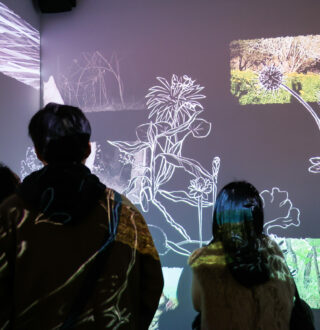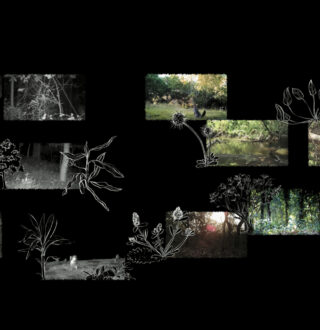Curator & Artist

Katharina Weikl
Are you ready to join us on a journey to explore the diverse wildlife in China, Switzerland, and around the world? Switzerland has been actively involved in biodiversity conservation research, and the adoption of the Swiss Biodiversity Strategy Action Plan in 2017 further enhanced these efforts. Educational and research institutions have utilized innovative techniques such as camera traps equipped with motion triggers and AI-powered data analysis to observe wildlife in their natural habitats.
One example is the video installation called "Triggered by Motion," which showcases this approach to wildlife observation. Developed initially at the University of Zurich and carried on by the Art x Science Office UZH, this installation utilizes camera trap data from 21 locations in 14 countries.
Among 21 camera traps of the Triggered by Motion project initiated by the University of Zurich, one camera was installed in China by Dr. Li Bicheng, a researcher from the Shanghai Natural History Museum, at Tian Ma Shan Forest Park in the suburbs of Shanghai. “Over 20 species in the suburban areas of Shanghai were recorded, including raccoon dogs, Palla’s squirrels, Chinese bulbul, Spotted dove, and others.”
“Through the collection of images and data, monitoring has contributed to local wildlife surveys, inspiring new approaches to wildlife management in highly urbanized environments. It allows people to learn about the wildlife around us and realize the importance of protecting them. ” Dr. Li Bicheng told us.
Two years ago, Swissnex in China brought the discussion of biodiversity around the Triggered By Motion project to our community in China. This December, we will showcase a new collaborative project: “Mirror of Nature” between Swissnex in China, the University of Zurich, and the Museum of Contemporary Art in Shanghai. Together, we will explore biodiversity and conservation projects worldwide by presenting an immersive exhibition and curating a series of talks and discussions alongside it. At the intersection of art, science, and technology, we hope to continue the scientific narratives of wildlife conservation in China and provide a Sino-Swiss platform for more meaningful exchanges among wildlife researchers, citizen scientists, artists, and the interested public.
Mirror of Nature: Biodiversity Through the Lens of Technology and Art
From 15th of December until 15th of January the Museum of Contemporay Art in Shanghai is showing the collaborative work “Mirror of Nature”. The immersive installation is a collaboration between wildlife researchers and biologists from University of Zurich and around the globe with a group of Chinese and European Artists: Sophie Hengartner, Alexandra Kaufmann, Helena Klein, Andi A. Müller, Karoline Schreiber and Zhu Yunyan.
Curated by Chinese poet and artist Han Bo, upon the invitation of Swissnex in China, and developed by the Art x Science Office at the University of Zurich, this exhibition serves as a testament to the collaborative efforts between China and Switzerland in exploring the subject of biodiversity. It aims to foster cross-border interdisciplinary cooperation and exchanges. Titled “Mirror of Nature (万物之镜),” the exhibition’s concept intertwines with Chinese philosophy, emphasizing our interconnected relationship with wildlife and the diverse ecosystem we inhabit.
“ With the artistic exploration of the scientific data, a shroud is being woven which follows patterns of remembrance and guilt. Simultaneously, the collision of both an artistic and scientific approach revives the souls and bodies of the extinct animals. As they move through the space of MoCA Pavilion they whisper of the unchangeable past and yet vow the still possible future.” — Dr. Katharina Weikl, Head of Art X Science at University of Zurich
“ Using contemporary “mirrors of nature” in the form of cameras equipped with motion sensors, the project aimed to collect visual data for a year in twenty-one biodiversity hotspots across fourteen countries. The approach prioritized minimizing disturbance to wild animals. The collected data was then processed using artificial intelligence technology, resembling a 21st-century “mirror of the heaven and earth.” However, this method of organizing the world reflects a tradition from Pythagoras-Plato, staunch believers in the idea that “all things are numbers” and that the underlying support for the eternal world is geometric or mathematical models. Guided by this belief, they sought to lift the entire world out of the Heraclitean “chaos” and rechristen it as a “cosmos” with a universal rational order.” — Han Bo, Poet, artist, novelist, playwright, travel writer, curator
[2023, video]
Concept: Katharina Weikl, Head of Art X Science at University of Zurich; Illustrations: Alexandra Kaufmann, Helena Klein, Sophie Hengartner
The video data from 21 biodiversity hotspots in 14 countries is originally used to scientifically examine the behaviors and communication of wildlife. Cameras with motion make it possible to monitor animals in the wild without disturbing them or influencing their behavior. Although the human body is rarely present in the space that is under surveillance, it is still very much present in its absence. Climate change and loss of habitat is an omnipresent threat. Whilst the seriousness of these topics can ́t be denied, the visual research material illustrates a surprisingly unmediated poetry which allows chance encounters with the most elusive species. Animations of recently extinct species remind us of the urgency to protect the biodiversity that is still left.
[2023, Video 15 ‘ 17 ”]
Karoline Schreiber
There are numerous animals threatened with extinction and many species no longer exist. They have been wiped out by humans. I am also a human being and therefore unfortunately partly responsible through my behavior, even though I don't want to be.
As an artist and draughtswoman, I was interested in this silent disappearance.
So I drew some extinct animal species with a broom and then wiped them away again. The drawings are in painterly motion and are reminiscent of early cave paintings.
[2023, Video Installation]
Claudia Röösli and Jochem Braakhekke, Department of Geography at University of Zurich in collaboration with HAN Bo
Celebrate the intersection of environmental awareness and arts with this thought- provoking video installation, fully compiled from free satellite data. Immerse yourself in
a captivating journey through time and space as timelapse videos unveil the dynamic transformations occurring on our planet: witness the stark realities of open-pit mines, the poignant retreat of glaciers, and the haunting scale of deforestation and urbanization. This evocative exploration serves as a powerful reminder of our collective responsibility to cherish and preserve the Earth's beauty, urging viewers to contemplate the impact of our actions.
[2023, Felt Works, Wool]
Zhu Yunyan
16 pieces of 10cm x 10cm felt artworks present partial fur patterns of extinct animals. Through a soft and warm tactile structure, they serve as a reminder that these animals once existed.
Curator & Artist
Katharina Weikl
Curator & Artist
Han Bo
Artist
Karoline Schreiber
Artist
Sophie Hengartner
Artist
Alexandra Kaufmann
Artist
Andi A. Müller
Artist
ZHU Yunyan
As the poetic art-science exhibition, "Mirror of Nature," draws to a close, our Swiss and Chinese curators, Dr. Katharina Weikl and HAN Bo, take a moment to reflect on this journey into wildlife. They shared their experiences, delved into the visionary and interdisciplinary nature of the project, and explored new possibilities for collaboration.
“Mirror of Nature: Biodiversity through the Lens of Technology and Art” is an art exhibition that delves into the realm of biological and environmental sciences. Hosted by Swissnex in China, and in collaboration with University of Zurich, the exhibition is currently on show from December 15, 2023 until January 15, 2024 at the Museum of Contemporary Art Shanghai Pavilion. Complemented by a curated series of dialogues and workshops, the project aims to inspire public engagement and foster an exchange of ideas that resonate beyond the confines of the museum walls.
Opening its door at the Pavilion of the Museum of Contemporary Art Shanghai on December 15, 2023, the immersive exhibition hosted by Swissnex in China - "Mirror of Nature: Biodiversity Through the Lens of Technology and Art" - unveils a global survey on animal behaviors initiated by the University of Zurich. We interviewed Dr. Katharina Weikl, the Swiss curator from the Art x Science Office at the University of Zurich, to hear her points of view about this collaborative work on wildlife conservation.
Get ready for a special experience as Swissnex in China presents a poetic art-science exhibition! Opening its doors at the Pavilion of the Museum of Contemporary Art in Shanghai on December 15 2023, this immersive showcase is a harmonious collaboration between wildlife researchers and biologists from the University of Zurich, along with artists from China and Europe.
University of Zurich
The University of Zurich is one of Europe’s leading research universities. And the largest university in Switzerland. Founded in 1833, UZH was the first university in Europe to be established by a democratic political system. With seven faculties covering around 100 different subjects, the university offers the widest range of degree programmes in Switzerland. It is currently ranked 5th in the world in the field of ecology by the Shanghai Ranking.
The Art x Science Office at University of Zurich bridges the gap between art, science and society. With installations and exhibitions in prestigious venues such as the Kunsthalle and Museum für Gestaltung (Zurich, Switzerland), the Mun Gallery in the Dongdaemun Design Plaza (Seoul, South Korea) and the Bengaluru Science Gallery (Bengaluru, India), the Art x Science Office has established an international presence and outreach.
Museum of Contemporary Art Shanghai (MoCA Shanghai)
Founded in 2005, MoCA is a pioneer private contemporary art museum established in China. It is committed to promoting contemporary art and design, with an aim to cultivate the appreciation of contemporary art and design for the general public. It is MoCA’s mission to introduce arts to the public and foster cultural exchange between Shanghai and the world.




















